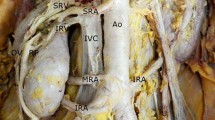Abstract
Using dissection and plastic injection followed by corrosion as study methods, we describe 16 cases of gonadal arteries originating from the renal artery. Among them, in 12 cases (75%), we assessed this variation on a single gonadal artery while two gonadal arteries appeared in four cases (25%). In 13 cases (81.25%) the gonadal arteries were located on the left side and in only three cases (18.75%) they were on the right. In seven cases (43.75%), an unique gonadal artery that originated from a single renal artery, in three cases (18.75%) the gonadal artery started from the artery of the inferior segment that started from the anterior branch of the renal artery, in other three cases (18.75%), from the trunk of the renal artery, prior to its terminal ramification and in one case (6.25%), from the artery of the superior segment that started from the anterior branch of the renal artery. In five cases (31.25%), a single gonadal artery started from a supplementary renal artery, in four cases (25%), from double renal arteries (three from the inferior and one from the superior one) and in a single case, from triple renal arteries (from the inferior one). All the four cases (25%) of double gonadal arteries were located on the left. Within them, in two cases, the two gonadal arteries started from the renal artery (unique or supplementary) and in the other two cases, the lateral gonadal artery originated from the renal artery (unique or supplementary) and the medial one from the aorta. This vascular variation shows a significant importance for renal surgery, in partial or total nephrectomy or in the renal transplant as long as it may lead to the compromise of the gonadal blood supply, mostly when the gonadal artery with renal origin is unique, without a second one with aortic or other arterial origin. A gonadal artery with origin from an inferior polar renal artery may be injured during the percutaneous treatment of the syndrome of pielo-ureteral junction, so it becomes a major contraindication. Also, this anatomical variation enhances the importance of the arteriography or Doppler ultrasound examination of the renal hylum. Sometimes, the gonadal artery may pass posterior to the proximal ureter that can be disturbed in traject, leading to hydronephrosis.



Similar content being viewed by others
References
Asala S, Chaudhary SC, Masumbuku-Kahamba N, Bidmos M (2001) Anatomical variations in the human testicular blood vessels. Ann Anat 183(6):545–549
Bergman RA, Cassel MD, Sahinoglu K, Heidger Jr PM (1992) Human doubled renal and testicular arteries. Anat Anz 174:313–315
Cicekcibasi AE, Salbacak A, Seker M, Ziylan T, Buyukmumcu M, Uysal II (2002) The origin of gonadal arteries in human fetuses: anatomical variations. Ann Anat 184(3):275–279
Conroy RM, Vander Molen RL (1976) Scrotal “Arteriocele” from the artery occlusion. Am J Roentgenol 127:670–672
Figley MM, Muller RF (1957) The arteries of the abdomen, pelvis, and thigh. I. Normal roentgenographic anatomy. II. Collateral circulation in obstructive arterial disease. Am J Roentgenol Radium Ther Nucl Med 77(2):296–311
Lippert H, Pabst R (1985) Arterial variation in man. JF Bergmann, Munchen, pp 28–29
Loukas M, Aparicio S, Beck A, Calderon R, Kennedy M (2005) Rare case of right accesory renal artery originating as a common trunk with the inferior mesenteric artery: a case report. Clin Anat 18:530–535
Machnicki A, Grzybiak M (1997) Variations in testicular arteries in fetuses and aduts. Folia Morphol 56:277–285
Ravery V, Cussenot O, Desgrandchamps F, Teillac P, Martin-Bouyer Y, Lassau JP (1993) Variations in arterial blood supply and the risk of hemorrhage during percutaneous treatment of lesions of the pelviureteral junction obstruction: report of a case of testicular artery arising from an inferior polar renal artery. Surg Radiol Anat 15(4):355–359
Shoja MM, Tubbs RS, Shakeri AB, Oakes WJ (2006) Origin of the gonadal artery: embryologic implication. Clin Anat (NCBI Epub ahead of print)
Singh G, Ng YK, Bay BH (1998) Bilateral accessory renal arteries associated with some anomalies of the ovarian arteries: a case study. Clin Anat 11(6):417–420
Author information
Authors and Affiliations
Corresponding author
Rights and permissions
About this article
Cite this article
Petru, B., Elena, Ş., Dan, I. et al. The morphology and the surgical importance of the gonadal arteries originating from the renal artery. Surg Radiol Anat 29, 367–371 (2007). https://doi.org/10.1007/s00276-007-0224-2
Received:
Accepted:
Published:
Issue Date:
DOI: https://doi.org/10.1007/s00276-007-0224-2




